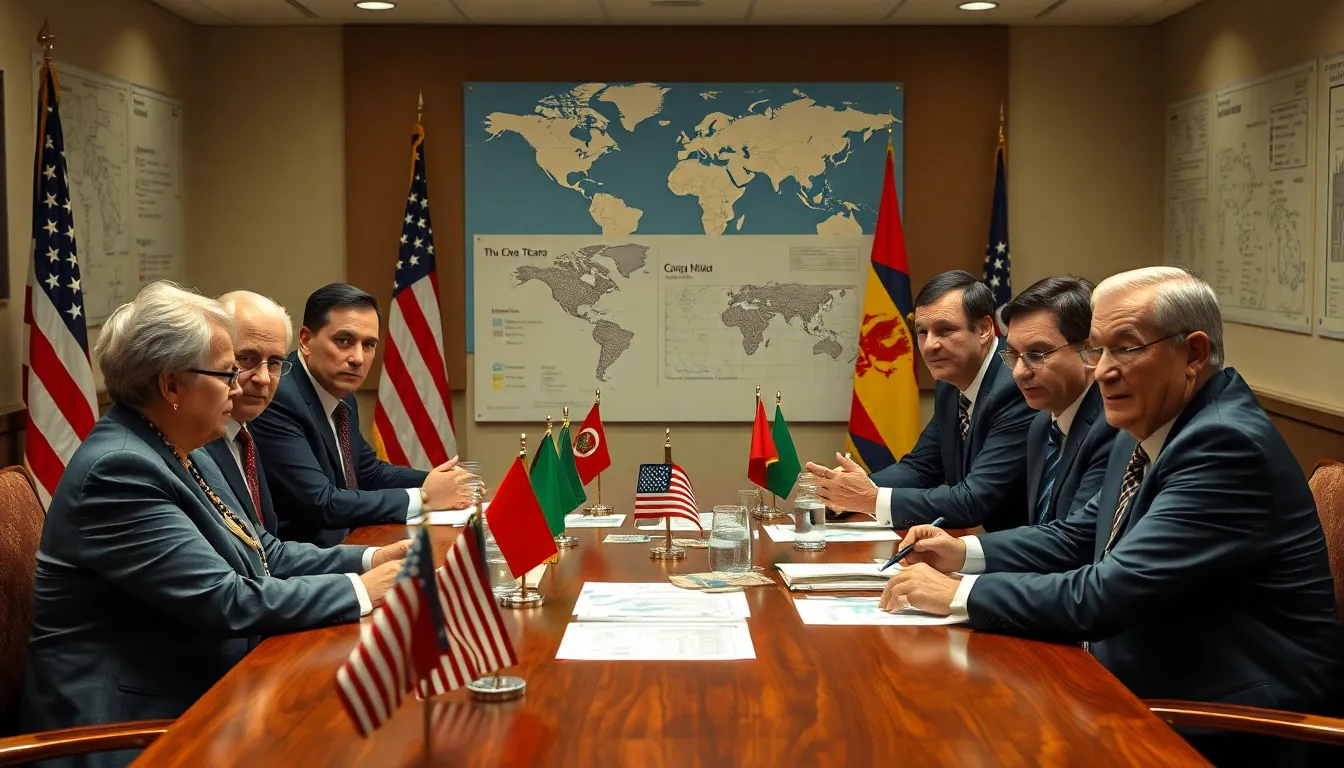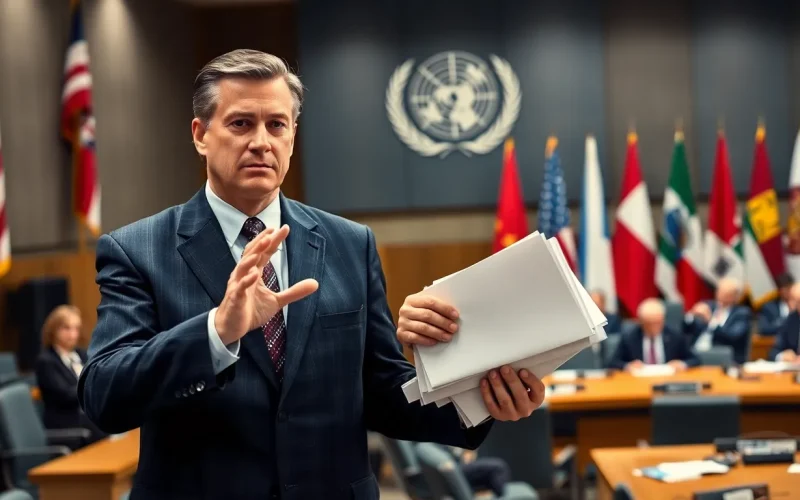Table of Contents
ToggleInternational conflicts are like that awkward family reunion where everyone’s got strong opinions and nobody wants to back down. From border disputes to trade wars, these clashes can escalate faster than a cat meme going viral. Understanding the roots and repercussions of these conflicts isn’t just for political junkies; it’s essential for anyone who wants to make sense of today’s world.
Overview Of International Conflicts
International conflicts arise from a variety of complex factors. Border disputes often create tensions between countries, jeopardizing regional stability. Trade wars signal economic hostilities, which can lead to significant financial consequences for all involved nations. Cultural differences also influence conflicts, as varying beliefs and practices clash in a globalized environment.
Several notable examples illustrate the current landscape. The ongoing Israel-Palestine conflict highlights longstanding territorial disputes and deep-rooted historical grievances. Tensions in the South China Sea demonstrate the volatility of maritime boundaries and resource claims. In Eastern Europe, the conflict in Ukraine reflects geopolitical competition and the struggle for national sovereignty.
Understanding the origins of these conflicts proves essential for effective resolution. Historical context provides insight into the motivations of conflicting parties. Grievances often extend back decades or even centuries, complicating negotiations. Analyzing economic impacts also reveals how trade relationships can both spark tension and foster cooperation.
The consequences of international conflicts extend beyond borders. Humanitarian crises emerge, displacing millions and straining global resources. Economic sanctions can lead to widespread suffering for civilian populations. Diplomatic relations may dissolve, isolating countries and diminishing opportunities for collaboration.
Research indicates that proactive measures can mitigate conflicts. Diplomacy encourages dialogue and fosters understanding among nations. International organizations, such as the United Nations, play critical roles in conflict resolution efforts. Embracing multilateral approaches often leads to more sustainable solutions, promoting peace and stability.
Causes Of International Conflicts

International conflicts stem from various root causes. They often intertwine political, economic, and social factors that escalate tensions between nations.
Political Causes
Political factors play a significant role in the emergence of international conflicts. Disputes over territorial claims frequently arise from historical grievances. Governments may prioritize national sovereignty, leading to confrontations with neighboring states. Rivalries among political entities can also foster instability. Authoritarian regimes often engage in aggressive foreign policies to distract citizens from domestic issues. Additionally, conflicting ideologies such as democracy versus autocracy generate tensions on a global scale. Political alliances, such as NATO or the Warsaw Pact, can intensify these rivalries, reinforcing divisions between countries.
Economic Causes
Economic interests frequently trigger international conflicts. Competition for resources such as oil, water, or minerals often leads to disputes. Nations reliant on trade for survival may engage in conflicts to protect economic interests. Trade wars often manifest through tariffs or sanctions, escalating economic hostilities. An unequal distribution of wealth can also foster resentment among nations. Furthermore, global financial crises can push countries to pursue aggressive policies to protect their economies. As economies become intertwined, disruptions in one region can lead to widespread consequences, exacerbating existing conflicts.
Social Causes
Social factors significantly influence international conflicts. Ethnic tensions often fuel animosities between distinct groups. Historical injustices and discrimination can lead to demands for self-determination or autonomy. Migration patterns sometimes exacerbate cultural clashes, resulting in xenophobia and hostility. Propaganda and misinformation can manipulate public perception, inciting conflicts driven by fear and misunderstanding. National identity plays a key role in shaping these dynamics, as perceived threats to cultural heritage can provoke violent responses. As societies evolve, unresolved social issues frequently contribute to the escalation of international tensions.
Notable International Conflicts
International conflicts shape global relations through significant historical events. Many exemplify ideological divides, territorial issues, and economic struggles.
World War I
World War I, lasting from 1914 to 1918, stemmed from complex alliances and nationalist tensions. Archduke Franz Ferdinand’s assassination triggered a conflict that escalated quickly. Major powers, including Germany, France, and Britain, became deeply involved. Over 30 countries participated, resulting in around 16 million deaths. The Treaty of Versailles ended the war, imposing heavy reparations on Germany, fostering resentment that contributed to future tensions.
World War II
World War II erupted in 1939 due to unresolved issues from World War I. Adolph Hitler’s aggressive expansionism prompted Britain and France to declare war. This conflict involved numerous nations across Europe, Asia, and the Pacific, leading to an estimated 70-85 million fatalities. The war introduced significant technological advances, including nuclear weapons, ultimately leading to the United Nations’ formation to prevent future conflicts. Economic devastation and political restructuring followed, shaping the modern world order.
The Cold War
The Cold War emerged post-World War II, characterized by ideological rivalry between the United States and the Soviet Union. While it did not lead to direct military confrontation, proxy wars in Korea and Vietnam illustrated the global stakes. This period, lasting from the late 1940s to 1991, involved an arms race and space race, along with widespread espionage. By promoting competing economic and political systems, the Cold War affected nations worldwide, influencing foreign policy and military strategies long after its end.
Impact Of International Conflicts
International conflicts create profound effects on societies, economies, and political landscapes worldwide. The ramifications touch nearly every aspect of affected nations and their populations.
Humanitarian Impact
Humanitarian crises often escalate due to international conflicts. Displacement of millions occurs, with refugee numbers reaching over 26 million globally as of 2023. Access to basic needs like food, clean water, and healthcare diminishes in conflict zones. In countries like Syria, ongoing violence has led to severe humanitarian emergencies impacting over 13 million people. Children in these areas experience disruptions in education and face psychological trauma. Loss of life stands as another stark reality, with fatalities compounding every day.
Economic Consequences
Economic ramifications from international conflicts are significant. War-torn regions see GDP contraction that can exceed 30% in some cases, leading to long-term economic instability. Trade disruptions become common as sanctions limit access to international markets. Industries collapse, jobs vanish, and existing infrastructure deteriorates. Nations experience inflation rates skyrocketing, putting fundamental goods out of reach for many. Investment flows redirect, often avoiding conflict-affected regions, stunting growth and development.
Political Ramifications
Political landscapes shift dramatically amid international conflicts. Regimes often face instability, with changes in government frequently following extended hostilities. National security becomes a priority, often at the expense of civil liberties and democratic processes. Diplomacy struggles under the weight of hostile relations, complicating negotiations for peace. Emerging political movements may arise, either promoting peace or, conversely, fueling further conflict. International alliances can also change as countries seek new partnerships to mitigate security threats or economic losses.
International conflicts are intricate and multifaceted challenges that require careful attention. Their roots lie in historical grievances political rivalries and economic disparities that can escalate into violence. The consequences extend far beyond the immediate regions affected often leading to humanitarian crises and global economic repercussions.
Addressing these conflicts demands a commitment to diplomacy and collaboration among nations. Understanding the underlying causes is key to fostering sustainable peace. As the world continues to grapple with these issues the need for effective conflict resolution strategies becomes increasingly urgent. Only through concerted efforts can nations hope to navigate the complexities of international relations and work toward a more stable future.





